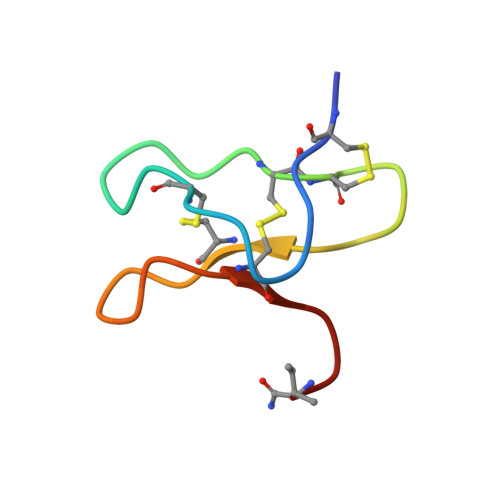Spider peptide toxin HwTx-IV engineered to bind to lipid membranes has an increased inhibitory potency at human voltage-gated sodium channel hNaV1.7.
Agwa, A.J., Lawrence, N., Deplazes, E., Cheneval, O., Chen, R.M., Craik, D.J., Schroeder, C.I., Henriques, S.T.(2017) Biochim Biophys Acta 1859: 835-844
- PubMed: 28115115
- DOI: https://doi.org/10.1016/j.bbamem.2017.01.020
- Primary Citation of Related Structures:
5TLR - PubMed Abstract:
The human voltage-gated sodium channel sub-type 1.7 (hNa V 1.7) is emerging as an attractive target for the development of potent and sub-type selective novel analgesics with increased potency and fewer side effects than existing therapeutics. HwTx-IV, a spider derived peptide toxin, inhibits hNa V 1.7 with high potency and is therefore of great interest as an analgesic lead. In the current study we examined whether engineering a HwTx-IV analogue with increased ability to bind to lipid membranes would improve its inhibitory potency at hNa V 1.7. This hypothesis was explored by comparing HwTx-IV and two analogues [E1PyrE]HwTx-IV (mHwTx-IV) and [E1G,E4G,F6W,Y30W]HwTx-IV (gHwTx-IV) on their membrane-binding affinity and hNa V 1.7 inhibitory potency using a range of biophysical techniques including computational analysis, NMR spectroscopy, surface plasmon resonance, and fluorescence spectroscopy. HwTx-IV and mHwTx-IV exhibited weak affinity for lipid membranes, whereas gHwTx-IV showed improved affinity for the model membranes studied. In addition, activity assays using SH-SY5Y neuroblastoma cells expressing hNa V 1.7 showed that gHwTx-IV has increased activity at hNa V 1.7 compared to HwTx-IV. Based on these results we hypothesize that an increase in the affinity of HwTx-IV for lipid membranes is accompanied by improved inhibitory potency at hNa V 1.7 and that increasing the affinity of gating modifier toxins to lipid bilayers is a strategy that may be useful for improving their potency at hNa V 1.7.
Organizational Affiliation:
Institute for Molecular Bioscience, The University of Queensland, Qld 4072, Australia.














